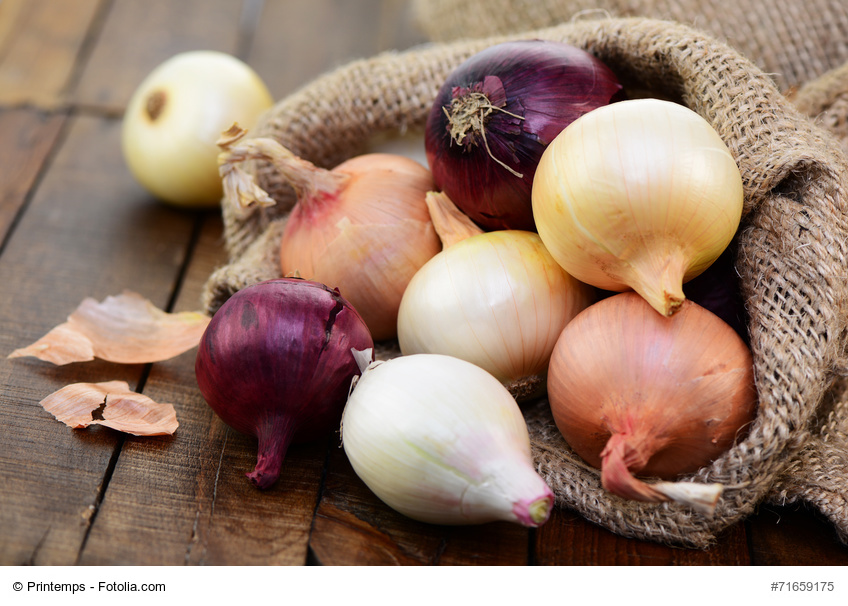It is the second big harvest in succession and actually nobody knows, where to go with Indian fresh onions. Officially it said that the decrease is only because of the huge crops. But this seems to be only one side of the coin. Because of privileged Indian Onion traders, state interventions and import duties prices of dried onions in Europe. Soon the new crop will arrive …..
Indian Trader: Kings of Onions
March 2017: every day the triple amount of onions are delivered to Lasalgoaon, Asia’s biggest Onion market. But where to go with it? No storage capacity and a shelf life of only four weeks, made Onion dealers to kings. They exploit the circumstances offering only very low prices.
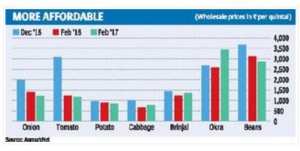
Onion prices in comparison
“There is too much in the market. We would need at least twenty days to transport the onions – but every day there are new arrivals,” said a worker on side. ,, It will need forty railroad cars to do the transport – but we only have 15!” Some farmers already burnt their harvested onions, because they did not even get back their costs of production. The reason for the big harvested quantities: good weather conditions and boosted productivity.
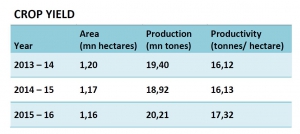
Onion Market
Alongside China, India is the second largest producer of fresh onions: more than 20 million mt. are harvested every year, mainly in Maharashtra (29%), Karnataka (15%), Madhya Pradesh (13%) and other regions in western India.
Globally 300.000 mt of dehydrated onions are traded annually – with a market share of 20 % India is the second largest supplier.
Fundamentally, we distinguish between “red” and “white” onions. While the red ones are more or less vegetables, white onions are dehydrated and processed as spices.
The Indian Onion Market
Harvests take place between September and May: pre-Karif (September), Kharif (Winter December/January) and Rabi (Summer-Harvest April/Mai). The Rabi crop in August takes about 65 % of the total harvested quantities. (1) Thus there are three price reactions: Winter crop in December, a further one within RABI in April and a third one in September/October.
After December crop the prices drop, because April’s harvest is soon. Six of the top Indian onion markets are in Maharashtra and Karnataka. Delhi, Gujarat and Rajastan have one market each. More than 50 % of the harvest has to come via those markets – being at hand of a small group of traders, being very influential and able to steer prices. Very often there are familiar relationships between those trader families. A trust. Traders deal with each other, so Karnataka dealers may deal with Maharashtra traders. (2)
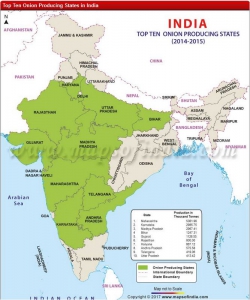
Indian Onion Regions
When April crop arrives, the Indian onion dealers begin to empty the market: sometimes they do it directly, sometimes with the help of middle-man. Their common goal is to keep the price for the farmers low. The Indian dealers’ goal is to store as much stocks as possible in their cooling houses to restrain them from the market.
When the cooling season is over, prices are boosted by more than 200 %, because by Pre-Kharif there are only small quantities to come in.
(1) https://qz.com/228874/the-solution-to-onion-price-inflation-is-right-before-our-eyes-hint-its-not-the-hoarders/
(2) http://www.business-standard.com/article/markets/onion-prices-crash-40-on-bumper-production-117022700636_1.html
Particular importance of onions in India
In India, onions are used as vegetables and are essential ingredients in the traditional cuisine. In the average, every Indian consumes nine to ten Kilograms of onions per year. Unless local crops do not cover local needs, the Indian even import fresh onions. In 2010, after an insufficient crop, the Indian government placed a ban to export onion to beware from hunger in India.
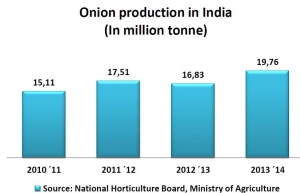
As a basic foodstuff, onions are also a political issue. According to the Indian understanding, the government has to guarantee the basic supply. In 1998, the government was nearly voted out of office, because it did not succeed to control prices for onions.
Since September 2013, the governmental responsibility had been fixed in the Food Security Act. With this law, 75 % of the rural and 50 % of the urban areas (800 Mio People) are eligible for national minimum food provisions. This was related to mainly to wheat and rice, but many people see it also in relation to onions.
The Agriculture Producte Marketing Act (APMC) had canalized the route to market of famers, who afterwards could only sell to fixed markets middleman – of course they had to pay for it. The aim of the Indian government was to protect the ignorant farmers. But the only one who really benefitted, were the middleman and the traders, who got rich. This law is not liberalized yet in all regions of India. (1)
Prices of onions are today an economical indicator – rising onion prices are automatically leading to inflation.
Dehydrated Onions
There are approximately 75 Onion Dehydration Companies in India – thereof 65 in Mahuva, in Bhavnagar District (Gujarat). Mahuva is producing approx. 70 % of the dehydrated Indian onions, predominantly with the winter crop.
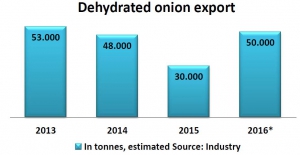
Source: National Horticulture Board, Indian Ministry of Agriculture
Approximately 30.000 mt dehydrated onions were exported in 2015, in 2016 this increased to 45.000 mt. It is in the stars, how many will be dried in 2017.
During dehydration, humidity of onions is reduced from 86 % to 7 %. Means you need 10 kg fresh onions to gain 1 kg dehydrated onions. So for 45.000 mt dehydrated onions 450.000 mt of fresh onions are needed.
In particular, Indian dehydration companies benefit from the price decreases – especially when dehydration takes place before cooling season. An exporter said: “Prices are actually very favorable because they help us to compete globally.” (2)
Governmental Regulations
As the state is responsible for the basic supply of food, the Indian government implemented some tools to prevent the people from hunger and to protect themselves against political riots, i.e.
the PSF (Price Stability Fonds) : buying onions at a fixed price and to store them, or
MSP (Minimum Support Price) for basic food.
But this MSP does not exist in all of the Indian regions and only 50 % of the farmers are able to sell at those MSP. (3) (4)
Farmers, who do not benefit from the MSP, are now looking for other crops to gain more profit. And because all of the farmers are doing the same at the same time, the next oversize crop is waiting. It is reported that this will be garlic instead of onions.
Why we should not calculate this….
Apart from the moral duty, we should not calculate with this. Especially Indian dealers, processors and exporters benefit from the onion baisse. European importers still have to cover transport costs, import duties and currencies. So we do not think that prices will decrease a lot more. Next year we will have another situation: less onions, more garlic!
(1) National Councel of Applied economic Research „Indian Onion Scenario“ , 2014
(2) http://www.business-standard.com/article/markets/falling-onion-prices-cheer-dehydration-industry-116101100414_1.html 13. Oktober 2017
(3) http://www.thehindu.com/news/national/karnataka/Mixed-response-to-announcement-of-minimum-support-price-for-onion/article16085798.ece
(4) Bundesministerium für Ernährung und Landwirtschaft, „Länderbericht Indien“ Stand Mai 2014, S. 13
All data given are according to our todays knowledge or opinion. They are without obligation.

